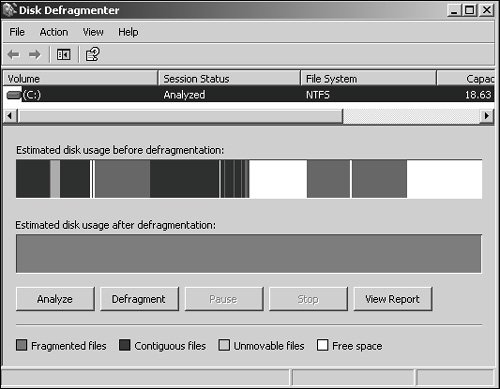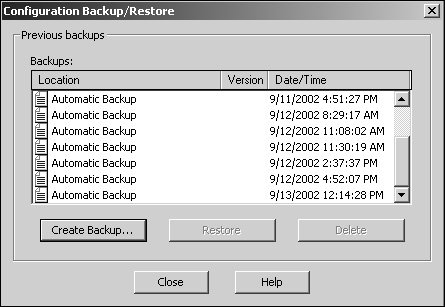Managing Windows Server 2003
| Many aspects of an IT infrastructure need to be managed. They can include managing servers based on their functional roles in the network environment, auditing network activity and usage, and monitoring the environment. Microsoft has come a long way with how servers can be managed. Windows Server 2003 management can be handled locally or remotely. Although local and remote management was possible in previous Windows versions, Windows Server 2003 supersedes that functionality with new and improved processes and tools that assist administrators in their management. Managing Based on Server RolesWindows Server 2003 systems can participate in various responsibilities in a given network environment. Some of these responsibilities may be intertwined due to budget constraints, business requirements, or technical justifications. No matter how the roles and responsibilities play out in the environment, it's important to manage them appropriately based on the roles of the server. The management aspects for some of the roles that Windows Server 2003 can undertake are examined in the following sections. File ServersFile servers are primarily responsible for keeping data. This data must be available and quickly accessed. As such, management of these servers can entail using the Disk Defragmenter utility, shown in Figure 22.1, to keep file access optimized. This helps keep reading and writing to disk more efficient than if files and the disk were fragmented. Figure 22.1. The Disk Defragmenter utility. Disk capacity must also be managed so that there is always ample space available for additional data. Quota management can also be an integral part of file server management. Disk quotas are used to control the amount of disk space that is available to the end users. When a disk quota is set, a specified amount of space on a volume can be set aside for a user. Warning messages can be sent to the user as the quota approaches the limit. This is illustrated in Figure 22.2. If an attempt to save data exceeds the limit, the user can be prevented from saving the file. Figure 22.2. Assigning disk quotas. Print ServersManaging print servers is an important but often overlooked aspect of managing Windows Server 2003. This is true mostly because printers on Windows Server 2003 are simple to manage. Although there is less management required for a print server, printing should still be audited and monitored. Auditing and monitoring printing ensures that users can print successfully and that the server and printers are fully operational. Print jobs on the server can be managed and viewed through either the printer queue or properties window. If the print server also has Internet printing enabled, print job information can be viewed using the print server's Web pages. The type of information that can be viewed and managed includes
In addition to the preceding information, the System Monitor can be used to provide a plethora of information about print usage on the system, such as
The information obtained from the print server listing can assist an administrator in proactively managing the printers and print devices. For instance, if it is determined that large print jobs performed at certain times of the day affect other print jobs, a print queue for large print jobs can be created to offload those jobs to after-hours printing only. Web ServersWindows Server 2003 Web servers offer an assortment of Internet-related functionalities, such as HTTP, FTP, SMTP, and more. Each of the services employed on the server must be managed to keep content and services up to date. The following are some areas to consider managing:
Figure 22.3. Verifying IIS metabase backups. Messaging ServersMessaging servers require special attention so that services run efficiently and effectively. In particular, Exchange servers require attention to the messaging databases, auditing, security, and user management. Exchange systems can be monitored using the System Monitor. Specific Exchange-related objects are installed so that administrators can easily pinpoint Exchange performance indicators. Exchange services are managed by the Exchange management snap-in as well as the Active Directory Users and Computers MMC snap-in. For instance, user accounts are mail-enabled in the Active Directory Users and Computers snap-in, while other configurations are managed through the Exchange management snap-in. Terminal ServersWindows Server 2003 Terminal Servers provide a thin-client approach to computing in which all the processing is done at the server. Only screen images, keystrokes, and mouse movements are sent to the client. Managing Terminal Servers can involve many aspects, including the following:
Domain ControllersDomain controllers (DCs) host Active Directory (AD), which contains most, if not all, objects in the Windows Server 2003 environment. AD has many functional roles in a Windows Server 2003 environment, including object management (additions, modifications, or deletions), authentication, replication, security, and more. Managing these AD roles can be intimidating, especially in larger environments, but AD has many useful utilities to help manage the directory. They include, but are not limited to, Active Directory Domains and Trusts, Active Directory Sites and Services, and Active Directory Users and Computers. Some of the areas that these tools can manage include
There are many other tools to manage that are included in Windows Server 2003 as command-line tools, Windows Server 2003 Support Tools, and the Windows Server 2003 Resource Kit. Also, countless third-party management utilities are developed specifically for AD. |
EAN: 2147483647
Pages: 499

